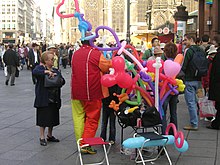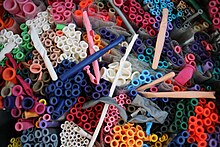| This article needs additional citations for verification. Please help improve this article by adding citations to reliable sources. Unsourced material may be challenged and removed. Find sources: "Balloon modelling" – news · newspapers · books · scholar · JSTOR (December 2019) (Learn how and when to remove this message) |

Balloon modelling or balloon twisting is the shaping of special modelling balloons into various shapes, often balloon animals. People who create balloon animals and other twisted balloon decoration sculptures are called twisters, balloon benders, and balloon artists. Twisters often perform in restaurants, at birthday parties, fairs and at public and private events or functions.
Two primary design styles are "single balloon modelling", which restricts itself to the use of one balloon per model, and "multiple balloon modelling", which uses more than one balloon. Each style has its own set of challenges and skills, and most twisters practise both styles. Depending on the needs of the moment, they might easily move between the one-balloon or multiple approaches, or they might even incorporate additional techniques such as "weaving" and "stuffing". Modelling techniques have evolved to include a range of very complex moves, and a highly specialized vocabulary has emerged to describe the techniques involved and their resulting creations.
Some twisters inflate their balloons with their own lungs, and for many years this was a standard and necessary part of the act. However, many now use a pump of some sort, whether it is a hand pump, an electric pump plugged in or run by a battery pack, or a compressed gas tank containing air or nitrogen. Twisters do not generally fill their creations with helium, as these designs will not usually float anyway. The balloons for twisting are too porous for helium and the designs are generally too heavy for their size for helium to lift.
Origins
The origins of balloon modelling are unknown. The 1975 book by "Jolly the Clown" Art Petri credits "Herman Bonnert from Pennsylvania at a magician's convention in 1939" as being the first balloontwister. Val Andrews, in Manual of Balloon Modeling, Vol. 1, An Encyclopedic Series, credits H.J. Bonnert of Scranton, Pennsylvania as being the "daddy of them all". Jim Church III states, "Frank Zacone from Youngstown, Ohio was doing a balloon act during the 1940s and had been doing the act for some time." Another candidate for first balloon twister is Henry Maar.
Equipment


Modellers will use an assortment of balloons, usually in various colors. Balloon sizes are usually identified by a number: the most common size of twisting balloons is called a "260", as it is approximately two inches in diameter and 60 inches long. Thus, a "260" is 2×60 inches and a "160" is 1×60 inches when fully blown up. Although these are the most common sizes used, there are dozens of other shapes available as well.
The most common methods for inflation are air pumps similar to bicycle pumps, electric air compressors, and the mouth. Inflating a balloon with the mouth is difficult and can be dangerous. Particularly well-trained and talented twisters, however, can blow-up several balloons at once, and some can even blow up 160s, which are much more difficult to mouth-inflate than the more common 260s, as their narrowness requires a great deal more strength and breath pressure to inflate.
See also
Notes
- "BalloonHQ Columns - Ralph Dewey". www.balloonhq.com. Retrieved 2022-07-13.
- ^ Balzer, Mark. "The History of Balloons". Balloon HQ. Retrieved 2022-07-13.
- Maar, Joseph.The Story of Henry Maar Archived 2007-09-30 at the Wayback Machine TMyers.com 6/20/06 Accessed 10/5/07
- Ballon, Môssieur. "Choosing the Right Modelling Balloons ?". www.mossieur-ballon.com. Retrieved 2022-07-13.
External links
| Parties and festivals | |||||||||||||||||
|---|---|---|---|---|---|---|---|---|---|---|---|---|---|---|---|---|---|
| Sorted by occasions, purposes or attributes | |||||||||||||||||
| Types |
| ||||||||||||||||
| Clothing |
| ||||||||||||||||
| Equipment | |||||||||||||||||